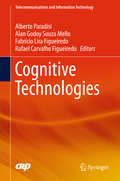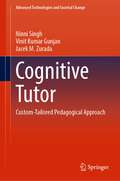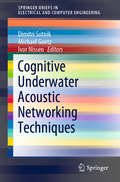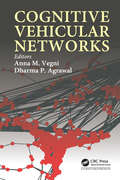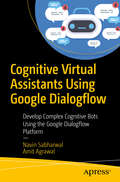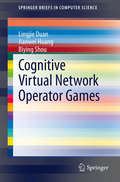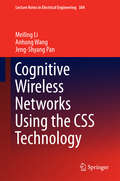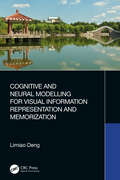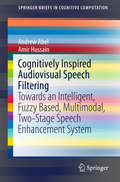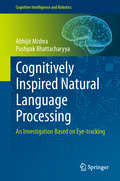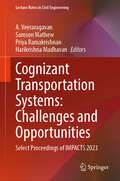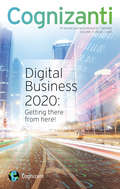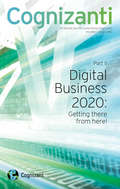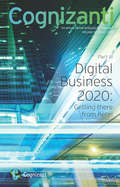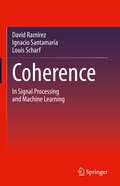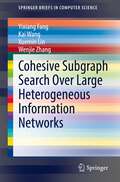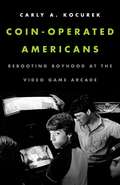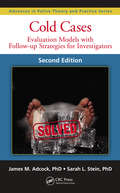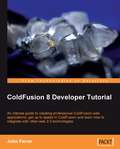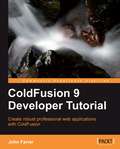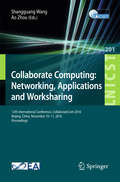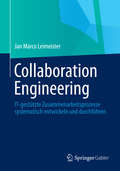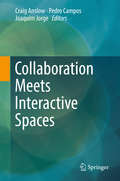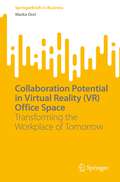- Table View
- List View
Cognitive Technologies (Telecommunications and Information Technology)
by Alberto Paradisi Fabrício Lira Figueiredo Alan Godoy Souza Mello Rafael Carvalho FigueiredoThis book focuses on the next generation optical networks as well as mobile communication technologies. The reader will find chapters on Cognitive Optical Network, 5G Cognitive Wireless, LTE, Data Analysis and Natural Language Processing. It also presents a comprehensive view of the enhancements and requirements foreseen for Machine Type Communication. Moreover, some data analysis techniques and Brazilian Portuguese natural language processing technologies are also described here.
Cognitive Tutor: Custom-Tailored Pedagogical Approach (Advanced Technologies and Societal Change)
by Vinit Kumar Gunjan Jacek M. Zurada Ninni SinghThis book illustrates the design, development, and evaluation of personalized intelligent tutoring systems that emulate human cognitive intelligence by incorporating artificial intelligence. Artificial intelligence is an advanced field of research. It is particularly used in the field of education to increase the effectiveness of teaching and learning techniques. With the advancement of internet technology, there is a rapid growth in web based distance learning modality. This mode of learning is better known as the e-learning system. These systems present low intelligence because they offer a pre-identified learning frame to their learners. The advantage of these systems is to offer to learn anytime and anyplace without putting emphasis on a learner's needs, competency level, and previous knowledge. Every learner has different grasping levels, previous knowledge, and preferred mode of learning, and hence, the learning process of one individual may significantly vary from other individuals. This book provides a complete reference for students, researchers, and industry practitioners interested in keeping abreast of recent advancements in this field. It encompasses cognitive intelligence and artificial intelligence which are very important for deriving a roadmap for future research on intelligent systems.
Cognitive Underwater Acoustic Networking Techniques (SpringerBriefs in Electrical and Computer Engineering)
by Michael Goetz Ivor Nissen Dimitri SotnikThis book summarizes the latest research on cognitive network-layer methods and smart adaptive physical-layer methods in underwater networks. Underwater communication requires extendable and delay-tolerant underwater acoustic networks capable of supporting multiple frequency bands, data rates and transmission ranges. The book also discusses a suitable foreground communication stack for mixed mobile/static networks, a technology that requires adaptive physical layer waveforms and cognitive network strategies with underlying cooperative and non-cooperative robust processes. The goal is to arrive at a universally applicable standard in the area of Underwater Internet-of-Things [ISO/IEC 30140, 30142, 30143].
Cognitive Vehicular Networks
by Anna Maria Vegni Dharma P. AgrawalA comprehensive text on both current and emerging areas of cognitive vehicular networks, this book focuses on a new class of mobile ad hoc networks. It uses a pedagogical approach utilizing cognitive aspects applied to vehicular environments and comprises contributions from well-known and high profile researchers in their respective specialties. The book provides significant technical and practical insights on different perspectives, starting from a basic background on cognitive radio, interrelated technologies, application to vehicular networks, technical challenges, and future trends.
Cognitive Virtual Assistants Using Google Dialogflow: Develop Complex Cognitive Bots Using the Google Dialogflow Platform
by Navin Sabharwal Amit AgrawalFollow a step-by-step, hands-on approach to building production-ready enterprise cognitive virtual assistants using Google Dialogflow. This book provides an overview of the various cognitive technology choices available and takes a deep dive into cognitive virtual agents for handling complex real-life use cases in various industries such as travel and weather. You’ll delve deeper into the advanced features of cognitive virtual assistants implementing features such as input/output context, follow-up intents, actions and parameters, and handling complex multiple intents. You’ll learn how to integrate with third-party messaging platforms by integrating your cognitive bot with Facebook messenger. You’ll also integrate with third-party APIs to enrich your cognitive bots using webhooks. Cognitive Virtual Assistants Using Google Dialogflow takes the complexity out of the cognitive platform and provides rich guidance which you can use when developing your own cognitive bots. The book covers Google Dialogflow in-depth and starts with the basics, serving as a hands-on guide for developers who are starting out on their journey with Google Dialogflow. All the code presented in the book will be available in the form of scripts and configuration files, which allows you to try out the examples and extend them in interesting ways.What You Will LearnDevelop cognitive bots with Google Dialogflow technologyUse advanced features to handle complex conversation scenariosEnrich the bot’s conversations by understanding the sentiment of the userSee best practices for developing cognitive botsEnhance a cognitive bot by integrating with third-party services Who This Book Is For AI and ML developers.
Cognitive Virtual Network Operator Games (SpringerBriefs in Computer Science)
by Jianwei Huang Lingjie Duan Biying ShouThis SpringerBrief provides an overview of cognitive mobile virtual network operator's (C-MVNO) decisions under investment flexibility, supply uncertainty, and market competition in cognitive radio networks. This is a new research area at the nexus of cognitive radio engineering and microeconomics. The authors focus on an operator's joint spectrum investment and service pricing decisions. The readers will learn how to tradeoff the two flexible investment choices (dynamic spectrum leasing and spectrum sensing) under supply uncertainty. Furthermore, if there is more than one operator, we present analysis of the competition among operators in obtaining spectrum and pricing services to attract users. The brief is designed for professionals working with C-MVNOs. Succinct and practical, it will assist them in making optimal investments and pricing decisions. It will also be of interest to researchers.
Cognitive Wireless Networks Using the CSS Technology (Lecture Notes in Electrical Engineering #384)
by Jeng-Shyang Pan Anhong Wang Meiling LiThe aim of this book is to provide someuseful methods to improve the spectrum sensing performance in a systematic way,and point out an effective method for the application of cognitive radiotechnology in wireless communications. The book gives a a state-of-the-artsurvey and proposes some new cooperative spectrum sensing (CSS) methodsattempting to achieve better performance. For each CSS, the main idea andcorresponding algorithm design are elaborated in detail. This book covers the fundamental concepts and the coretechnologies of CSS, especially its latest developments. Each chapter ispresented in a self-sufficient and independent way so that the reader canselect the chapters interesting to them. The methodologies are described indetail so that the readers can repeat the corresponding experiments easily. It will be a useful book for researchers helping them tounderstand the classifications of CSS, inspiring new ideas about the novel CSStechnology for CR, and learning new ideas from the current status of CSS. Forengineers, it will be a good guidebook to develop practical applications forCSS.
Cognitive and Neural Modelling for Visual Information Representation and Memorization
by Limiao DengFocusing on how visual information is represented, stored and extracted in the human brain, this book uses cognitive neural modeling in order to show how visual information is represented and memorized in the brain. Breaking through traditional visual information processing methods, the author combines our understanding of perception and memory from the human brain with computer vision technology, and provides a new approach for image recognition and classification. While biological visual cognition models and human brain memory models are established, applications such as pest recognition and carrot detection are also involved in this book. Given the range of topics covered, this book is a valuable resource for students, researchers and practitioners interested in the rapidly evolving field of neurocomputing, computer vision and machine learning.
Cognitively Inspired Audiovisual Speech Filtering: Towards an Intelligent, Fuzzy Based, Multimodal, Two-Stage Speech Enhancement System (SpringerBriefs in Cognitive Computation #5)
by Amir Hussain Andrew AbelThis book presents a summary of the cognitively inspired basis behind multimodal speech enhancement, covering the relationship between audio and visual modalities in speech, as well as recent research into audiovisual speech correlation. A number of audiovisual speech filtering approaches that make use of this relationship are also discussed. A novel multimodal speech enhancement system, making use of both visual and audio information to filter speech, is presented, and this book explores the extension of this system with the use of fuzzy logic to demonstrate an initial implementation of an autonomous, adaptive, and context aware multimodal system. This work also discusses the challenges presented with regard to testing such a system, the limitations with many current audiovisual speech corpora, and discusses a suitable approach towards development of a corpus designed to test this novel, cognitively inspired, speech filtering system.
Cognitively Inspired Natural Language Processing: An Investigation Based on Eye-tracking (Cognitive Intelligence and Robotics)
by Pushpak Bhattacharyya Abhijit MishraThis book shows ways of augmenting the capabilities of Natural Language Processing (NLP) systems by means of cognitive-mode language processing. The authors employ eye-tracking technology to record and analyze shallow cognitive information in the form of gaze patterns of readers/annotators who perform language processing tasks. The insights gained from such measures are subsequently translated into systems that help us (1) assess the actual cognitive load in text annotation, with resulting increase in human text-annotation efficiency, and (2) extract cognitive features that, when added to traditional features, can improve the accuracy of text classifiers. In sum, the authors’ work successfully demonstrates that cognitive information gleaned from human eye-movement data can benefit modern NLP. Currently available Natural Language Processing (NLP) systems are weak AI systems: they seek to capture the functionality of human language processing, without worrying about how this processing is realized in human beings’ hardware. In other words, these systems are oblivious to the actual cognitive processes involved in human language processing. This ignorance, however, is NOT bliss! The accuracy figures of all non-toy NLP systems saturate beyond a certain point, making it abundantly clear that “something different should be done.”
Cognizant Transportation Systems: Select Proceedings of IMPACTS 2023 (Lecture Notes in Civil Engineering #263)
by A. Veeraragavan Samson Mathew Priya Ramakrishnan Harikrishna MadhavanThis book presents the select proceedings of the International Conference on Innovative Methods and Practical Applications for Cognizant Transportation Systems (IMPACTS 2023). It explores the most recent methods of analysis and design of transportation systems, such as congestion, traffic safety, and high pollution levels, that can adapt to the ever-changing demands of urbanization. This compilation of research papers on the themes of traffic engineering, pavement technology and transportation planning, intelligent transportation systems, and environmental sustainability presents a unique blend of pragmatism and theoretical perspective to the varied challenges that transportation systems face. This book is a valuable resource for researchers and professionals associated with transportation engineering.
Cognizanti - Volume 7: Cognizanti An annual journal produced by Cognizant
by Thomas Kelly Robert Hoyle Brown Alan Alper Gary Beach Steven Delacastro Nagaraja Srivatsan Aita Salasoo Benjamin Pring Bruce Rogow Akhil Tandulwadikar Amy Brady Nitin Virmani Sandeep Andugula Angus Burgess Jeff BoyleSeeing the Digital Future through a 2020 Lens In this issue, our authors peer over the horizon into the next decade to see how Code Halos will create engaging and even clairvoyant enterprises that can read the minds of customers, employees and business partners, and deliver personalized products and services that offer true value at the moment of need, sometimes even before the need is realized.
Cognizanti - Volume 8: Cognizanti An annual journal produced by Cognizant
by Reshma Trenchil Adithya Sastry William Shea Robert Hoyle Brown Manoj Narayanan Alan Alper Kipp Lynch Nitin Bajaj Sanjay Fuloria Theodore Forbath Gary Beach Anand Chandramouli Patricia Birch Bruce J. Rogow Steven Delacastro Prasad Chintamaneni Anbu G. Muppidathi Sripriya KalyanasundaramKeeping Business Simple, But Meaningful This issue is dedicated to the simplicity promised, but not guaranteed, by digital business. It illuminates the possibilities and pitfalls, while offering concrete ideas and inspiration to those seeking to jumpstart or accelerate the digital journey.
Cognizanti: An annual journal produced by Cognizant | VOLUME 9 ISSUE 1 2016 ((Part III) Digital Business 2020: Getting there from here! #3)
by Matthew Smith Reshma Trenchil Alan Alper Gary Beach Anand Chandramouli Bruce J. Rogow Stan Iyer Rajaram Radhakrishnan Mary Murphy-Hoye Prasad Satyavolu David Delano Rob Ao2 Ted Shelton Rob Asen Asen Burkhard Blechschmidt Jagan Ramachandran Manish Bahl Dharmesh MistryProgress on the Path to Digital Authenticity This edition of Cognizanti explores the essence of what it means to be digital (think of a digital-to-the-core attitude and customer autonomy as critical operating constructs) and amplifies the role that the thoroughly modern CIO can play in helping organizations achieve progress, both from a leadership and "gig" economy point of view. From there, we examine the evolving world of intel-ligent automation (systems that do, think, learn and adapt), as well as the emerging landscape of business platforms, where companies of all sizes and shapes can plug and play in ecosystems that they either own, manage or merely participate in. This new approach introduces an interesting variation on the "co-opetition" theme that has pervaded business for the past few decades.
Coherence: In Signal Processing and Machine Learning
by Louis Scharf David Ramírez Ignacio SantamaríaThis book organizes principles and methods of signal processing and machine learning into the framework of coherence. The book contains a wealth of classical and modern methods of inference, some reported here for the first time. General results are applied to problems in communications, cognitive radio, passive and active radar and sonar, multi-sensor array processing, spectrum analysis, hyperspectral imaging, subspace clustering, and related. The reader will find new results for model fitting; for dimension reduction in models and ambient spaces; for detection, estimation, and space-time series analysis; for subspace averaging; and for uncertainty quantification. Throughout, the transformation invariances of statistics are clarified, geometries are illuminated, and null distributions are given where tractable. Stochastic representations are emphasized, as these are central to Monte Carlo simulations. The appendices contain a comprehensive account of matrix theory, the SVD, the multivariate normal distribution, and many of the important distributions for coherence statistics. The book begins with a review of classical results in the physical and engineering sciences where coherence plays a fundamental role. Then least squares theory and the theory of minimum mean-squared error estimation are developed, with special attention paid to statistics that may be interpreted as coherence statistics. A chapter on classical hypothesis tests for covariance structure introduces the next three chapters on matched and adaptive subspace detectors. These detectors are derived from likelihood reasoning, but it is their geometries and invariances that qualify them as coherence statistics. A chapter on independence testing in space-time data sets leads to a definition of broadband coherence, and contains novel applications to cognitive radio and the analysis of cyclostationarity. The chapter on subspace averaging reviews basic results and derives an order-fitting rule for determining the dimension of an average subspace. These results are used to enumerate sources of acoustic and electromagnetic radiation and to cluster subspaces into similarity classes. The chapter on performance bounds and uncertainty quantification emphasizes the geometry of the Cramèr-Rao bound and its related information geometry.
Cohesive Subgraph Search Over Large Heterogeneous Information Networks (SpringerBriefs in Computer Science)
by Wenjie Zhang Xuemin Lin Kai Wang Yixiang FangThis SpringerBrief provides the first systematic review of the existing works of cohesive subgraph search (CSS) over large heterogeneous information networks (HINs). It also covers the research breakthroughs of this area, including models, algorithms and comparison studies in recent years. This SpringerBrief offers a list of promising future research directions of performing CSS over large HINs.The authors first classify the existing works of CSS over HINs according to the classic cohesiveness metrics such as core, truss, clique, connectivity, density, etc., and then extensively review the specific models and their corresponding search solutions in each group. Note that since the bipartite network is a special case of HINs, all the models developed for general HINs can be directly applied to bipartite networks, but the models customized for bipartite networks may not be easily extended for other general HINs due to their restricted settings. The authors also analyze and compare these cohesive subgraph models (CSMs) and solutions systematically. Specifically, the authors compare different groups of CSMs and analyze both their similarities and differences, from multiple perspectives such as cohesiveness constraints, shared properties, and computational efficiency. Then, for the CSMs in each group, the authors further analyze and compare their model properties and high-level algorithm ideas.This SpringerBrief targets researchers, professors, engineers and graduate students, who are working in the areas of graph data management and graph mining. Undergraduate students who are majoring in computer science, databases, data and knowledge engineering, and data science will also want to read this SpringerBrief.
Cohort Intelligence: A Socio-inspired Optimization Method (Intelligent Systems Reference Library #114)
by Ajith Abraham Anand Jayant Kulkarni Ganesh KrishnasamyThis Volume discusses the underlying principles and analysis of the different concepts associated with an emerging socio-inspired optimization tool referred to as Cohort Intelligence (CI). CI algorithms have been coded in Matlab and are freely available from the link provided inside the book. The book demonstrates the ability of CI methodology for solving combinatorial problems such as Traveling Salesman Problem and Knapsack Problem in addition to real world applications from the healthcare, inventory, supply chain optimization and Cross-Border transportation. The inherent ability of handling constraints based on probability distribution is also revealed and proved using these problems.
Coin-Operated Americans: Rebooting Boyhood at the Video Game Arcade
by Carly A. KocurekVideo gaming: it&’s a boy&’s world, right? That&’s what the industry wants us to think. Why and how we came to comply are what Carly A. Kocurek investigates in this provocative consideration of how an industry&’s craving for respectability hooked up with cultural narratives about technology, masculinity, and youth at the video arcade.From the dawn of the golden age of video games with the launch of Atari&’s Pong in 1972, through the industry-wide crash of 1983, to the recent nostalgia-bathed revival of the arcade, Coin-Operated Americans explores the development and implications of the &“video gamer&” as a cultural identity. This cultural-historical journey takes us to the Twin Galaxies arcade in Ottumwa, Iowa, for a close look at the origins of competitive gaming. It immerses us in video gaming&’s first moral panic, generated by Exidy&’s Death Race (1976), an unlicensed adaptation of the film Death Race 2000. And it ventures into the realm of video game films such as Tron and WarGames, in which gamers become brilliant, boyish heroes.Whether conducting a phenomenological tour of a classic arcade or evaluating attempts, then and now, to regulate or eradicate arcades and coin-op video games, Kocurek does more than document the rise and fall of a now-booming industry. Drawing on newspapers, interviews, oral history, films, and television, she examines the factors and incidents that contributed to the widespread view of video gaming as an enclave for young men and boys.A case study of this once emergent and now revived medium became the presumed enclave of boys and young men, Coin-Operated Americans is history that holds valuable lessons for contemporary culture as we struggle to address pervasive sexism in the domain of video games—and in the digital working world beyond.
Cold Cases: Evaluation Models with Follow-up Strategies for Investigators, Second Edition (Advances in Police Theory and Practice)
by James M. Adcock Sarah L. SteinBecause the investigation of cold cases is usually an arduous and time-consuming task, most law enforcement agencies in the United States are not able to dedicate the resources necessary to support the cold case investigation process. However, when those cases are fully pursued and prosecuted, they often result in convictions and lengthy prison terms. Cold Cases: Evaluation Models with Follow-up Strategies for Investigators, Second Edition saves law enforcement time by providing detailed guidelines for determining if a cold case is solvable, and if so, how to organize, manage, and evaluate the investigation. It also provides techniques for developing investigative strategies to complement the evaluation process and resolve the crime.This second edition features a new revised model and methodology for investigating cold cases suitable for all police and public safety agencies—large or small, domestic or international. This new model is more expeditious and convenient for departments that have less manpower and experience in dealing with cold cases. It emphasizes the prioritization of cold cases based on the availability of physical evidence and the chances of deriving matches from said evidence and an identified person of interest.Additional topics covered in the second edition include: How cases go cold Strategies for creating a cold case unit Cold case investigations in a Dutch educational environment—a chapter written by members of the Dutch Police Academy New forensic science technologies, including DNA, CODIS, and AFIS Case studies demonstrating advances in suspectology Strategies for effective investigative interviewing Challenges posed by staged crime scenes in cold cases How to craft a cold case evaluation report The expert authors of this book maintain The Center for the Resolution of Unresolved Crimes and conduct training and consulting worldwide. Their practical book is designed to help law enforcement agencies resurrect long-forgotten cases, bringing closure to victims and holding accountable those who are responsible. This book is part of the Advances in Police Theory and Practice series
ColdFusion 8 Developer Tutorial
by John FarrarThis book is a fast-paced tutorial to developing ColdFusion applications, with an emphasis on real-world skills. Packed with examples and careful explanations, the book leads you through all the topics relevant to today's ColdFusion developer. This book is for web developers working with ColdFusion 8. If your goal is to get a good grounding in the basics of the language as quickly as possible and put a site together quickly, this book is ideal for you. If you want to learn more about professional programming of ColdFusion, this book is definitely for you. No prior knowledge of ColdFusion is expected, but basic knowledge of general web and software development skills is assumed.
ColdFusion 8 Developer Tutorial
by John FarrarThis book is a fast-paced tutorial to developing ColdFusion applications, with an emphasis on real-world skills. Packed with examples and careful explanations, the book leads you through all the topics relevant to today's ColdFusion developer. This book is for web developers working with ColdFusion 8. If your goal is to get a good grounding in the basics of the language as quickly as possible and put a site together quickly, this book is ideal for you. If you want to learn more about professional programming of ColdFusion, this book is definitely for you. No prior knowledge of ColdFusion is expected, but basic knowledge of general web and software development skills is assumed.
Collaborate Computing: 12th International Conference, CollaborateCom 2016, Beijing, China, November 10–11, 2016, Proceedings (Lecture Notes of the Institute for Computer Sciences, Social Informatics and Telecommunications Engineering #201)
by Shangguang Wang Ao ZhouThis book constitutes the thoroughly refereed proceedings of the 12th International Conference on Collaborative Computing: Networking, Applications, and Worksharing, CollaborateCom 2016, held in Beijing, China, in November 2016. The 66 papers presented were carefully reviewed and selected from 116 submissions and focus on topics such as: participatory sensing, crowdsourcing, and citizen science; architectures, protocols, and enabling technologies for collaborative computing networks and systems; autonomic computing and quality of services in collaborative networks, systems, and applications; collaboration in pervasive and cloud computing environments; collaboration in data-intensive scientific discovery; collaboration in social media; big data and spatio-temporal data in collaborative environments/systems; collaboration techniques in data-intensive computing and cloud computing.
Collaboration Engineering: IT-gestützte Zusammenarbeitsprozesse systematisch entwickeln und durchführen
by Jan Marco LeimeisterIn Zeiten verteilter Wertschöpfungsstrukturen spielt die effektive Zusammenarbeit eine entscheidende Rolle im Kampf um Wettbewerbsvorteile. Diese Zusammenarbeit in Form von übertragbaren Prozessen zu gestalten, ist Kern des Collaboration Engineerings. Das Buch liefert einen umfassenden, auch für den Laien verständlichen Einblick in die Konzepte und Methoden, Werkzeuge und Anwendungen computerunterstützter Zusammenarbeit und betrachtet ihre Potenziale und Perspektiven. Ein Lehrbuch für Studierende und zugleich Handbuch für Entwickler und Anwender.
Collaboration Meets Interactive Spaces: Theory And Practice
by Joaquim Jorge Pedro Campos Craig AnslowThis book explores the technological advances and social interactions between interactive spaces, surfaces and devices, aiming to provide new insights into emerging social protocols that arise from the experimentation and long-term usage of interactive surfaces. This edited volume brings together researchers from around the world who investigate interactive surfaces and interaction techniques within large displays, wearable devices, software development, security and emergency management. Providing both theory and practical case studies, the authors look at current developments and challenges into 3D visualization, large surfaces, the interplay of mobile phone devices and large displays, wearable systems and head mounted displays (HMD'S), remote proxemics and interactive wall displays and how these can be employed throughout the home and work spaces. Collaboration Meets Interactive Spaces is both for researchers and industry practitioners, providing readers with a coherent narrative into the current state-of-the-art within interactive surfaces and pervasive display technology, providing necessary tools and techniques as interactive media increasingly permeates everyday contexts.
Collaboration Potential in Virtual Reality: Transforming the Workplace of Tomorrow (SpringerBriefs in Business)
by Marko OrelThe recent shift in labour markets has heightened the demand for alternative work arrangements. Virtual reality (VR) technology plays a significant role in this transition, with remote work as efficient as work performed from an organization's own office space. This book explores the impact of immersive VR technology on the new virtual workspace. Specifically, it examines how VR can enable employees to overcome the distractions associated with working from home, increase their visibility on team projects, build stronger relationships with co-workers, reduce feelings of isolation due to social distancing, and facilitate their engagement in collaborative work processes. It also explores the limitations of two-dimensional, computer-mediated communication tools for flexible working arrangements. It, thus, offers theoretical foundations for future research on office digitalization and subsequent applications of VR technology on office work. It also features the analysis of two dozen problem-centered expert interviews with creators and executives of leading productivity VR tools that enable the remote collaboration between knowledge workers.
